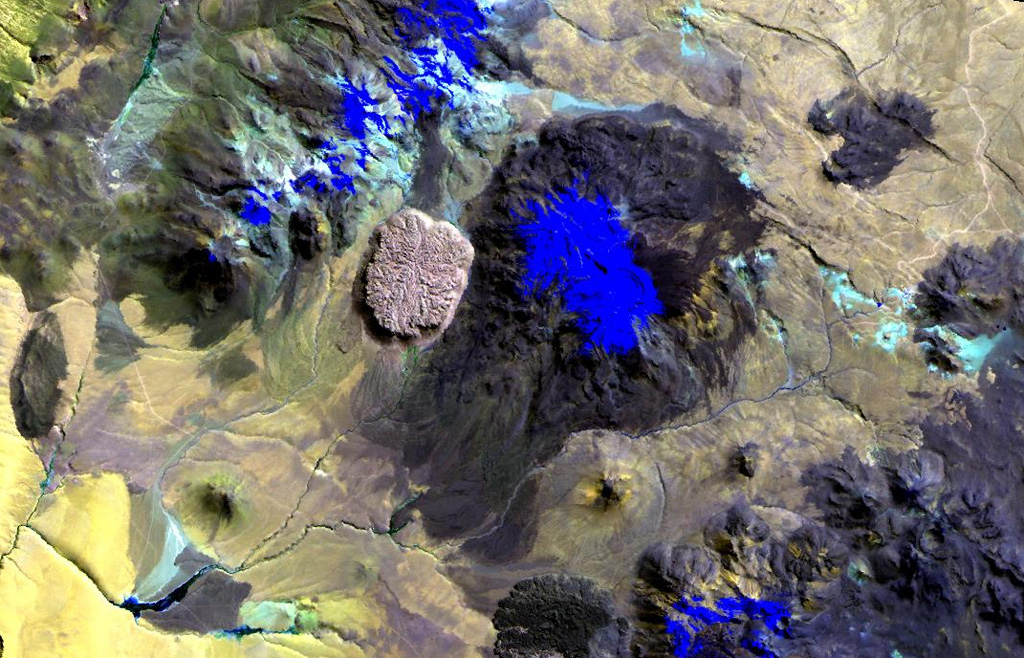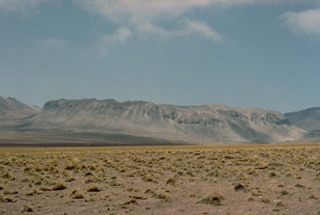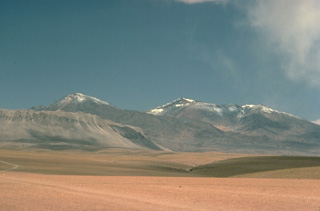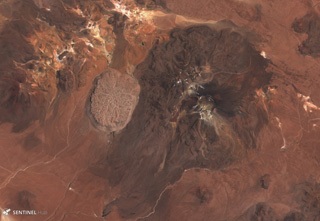

The Global Volcanism Program has no activity reports available for Cerros de Tocorpuri.
The Global Volcanism Program has no Weekly Reports available for Cerros de Tocorpuri.
The Global Volcanism Program has no Bulletin Reports available for Cerros de Tocorpuri.
|
|
||||||||||||||||||
The Global Volcanism Program is not aware of any Holocene eruptions from Cerros de Tocorpuri. If this volcano has had large eruptions (VEI >= 4) prior to 12,000 years ago, information might be found on the Cerros de Tocorpuri page in the LaMEVE (Large Magnitude Explosive Volcanic Eruptions) database, a part of the Volcano Global Risk Identification and Analysis Project (VOGRIPA).
This compilation of synonyms and subsidiary features may not be comprehensive. Features are organized into four major categories: Cones, Craters, Domes, and Thermal Features. Synonyms of features appear indented below the primary name. In some cases additional feature type, elevation, or location details are provided.
Synonyms |
||||
| Tocopuri, Cerro de | ||||
Domes |
||||
| Feature Name | Feature Type | Elevation | Latitude | Longitude |
| Torta, Cerro la | Dome | 5018 m | 22° 26' 0.00" S | 67° 58' 0.00" W |
 Cerro la Torta, the flat-topped ridge on the horizon, is a Holocene dacitic lava dome on the western side of Cerros de Tocorpuri volcano. Because of its distinctive shape, the dome is referred to locally by the Spanish word for cake (torta). Cerro la Torta, seen here from the west, is a roughly 5 cu km circular dome with a flat surface wrinkled by flow ridges and steep, 150-m-high talus-covered flanks. Emplacement of the 5090-m-high dome began with minor explosive activity, but slow lava extrusion was dominant.
Cerro la Torta, the flat-topped ridge on the horizon, is a Holocene dacitic lava dome on the western side of Cerros de Tocorpuri volcano. Because of its distinctive shape, the dome is referred to locally by the Spanish word for cake (torta). Cerro la Torta, seen here from the west, is a roughly 5 cu km circular dome with a flat surface wrinkled by flow ridges and steep, 150-m-high talus-covered flanks. Emplacement of the 5090-m-high dome began with minor explosive activity, but slow lava extrusion was dominant.  Cerros de Tocorpuri, seen here from the west, is a Pleistocene stratovolcano complex on the Chile-Bolivia border. A Holocene lava dome on its western foot, Cerro la Torta, forms the light-colored ridge at the left foreground. The circular, roughly 5 cu km Cerro la Torta was erupted from a central vent and is surrounded by a flat-topped surface with wrinkled flow ridges. The flow terminates in steep, talus-covered margins about 150-m high. Lava extrusion was preceded by minor silicic explosive eruptions.
Cerros de Tocorpuri, seen here from the west, is a Pleistocene stratovolcano complex on the Chile-Bolivia border. A Holocene lava dome on its western foot, Cerro la Torta, forms the light-colored ridge at the left foreground. The circular, roughly 5 cu km Cerro la Torta was erupted from a central vent and is surrounded by a flat-topped surface with wrinkled flow ridges. The flow terminates in steep, talus-covered margins about 150-m high. Lava extrusion was preceded by minor silicic explosive eruptions. The youthful-looking rhyolitic lava dome, Cerro la Torta (left of center), lies at its western foot of Cerros de Tocorpuri (or Volcán Tocorpuri), a stratovolcano complex on the Chile-Bolivia border. The circular, roughly 5 cu km Cerro la Torta has a flat-topped surface with wrinkled flow ridges and terminates in steep, talus-covered margins about 150 m high. The dome has a youthful appearance, but its age is not precisely known. Snow cover in this Landsat view is deep blue.
The youthful-looking rhyolitic lava dome, Cerro la Torta (left of center), lies at its western foot of Cerros de Tocorpuri (or Volcán Tocorpuri), a stratovolcano complex on the Chile-Bolivia border. The circular, roughly 5 cu km Cerro la Torta has a flat-topped surface with wrinkled flow ridges and terminates in steep, talus-covered margins about 150 m high. The dome has a youthful appearance, but its age is not precisely known. Snow cover in this Landsat view is deep blue.  The Cerro la Torta lava dome formed on the western flank of Cerros de Tocorpuri around 34 ka, shown in this 5 November 2019 Sentinel-2 satellite image (N is at the top). The N-S length of the dome is 4 km with an areal extent of 12 km2, and a 4.7 km3 volume. The complex is located along the Chile-Bolivia border.
The Cerro la Torta lava dome formed on the western flank of Cerros de Tocorpuri around 34 ka, shown in this 5 November 2019 Sentinel-2 satellite image (N is at the top). The N-S length of the dome is 4 km with an areal extent of 12 km2, and a 4.7 km3 volume. The complex is located along the Chile-Bolivia border.There are no samples for Cerros de Tocorpuri in the Smithsonian's NMNH Department of Mineral Sciences Rock and Ore collection.
| Copernicus Browser | The Copernicus Browser replaced the Sentinel Hub Playground browser in 2023, to provide access to Earth observation archives from the Copernicus Data Space Ecosystem, the main distribution platform for data from the EU Copernicus missions. |
|
WOVOdat
Single Volcano View Temporal Evolution of Unrest Side by Side Volcanoes |
WOVOdat is a database of volcanic unrest; instrumentally and visually recorded changes in seismicity, ground deformation, gas emission, and other parameters from their normal baselines. It is sponsored by the World Organization of Volcano Observatories (WOVO) and presently hosted at the Earth Observatory of Singapore.
GVMID Data on Volcano Monitoring Infrastructure The Global Volcano Monitoring Infrastructure Database GVMID, is aimed at documenting and improving capabilities of volcano monitoring from the ground and space. GVMID should provide a snapshot and baseline view of the techniques and instrumentation that are in place at various volcanoes, which can be use by volcano observatories as reference to setup new monitoring system or improving networks at a specific volcano. These data will allow identification of what monitoring gaps exist, which can be then targeted by remote sensing infrastructure and future instrument deployments. |
| IRIS seismic stations/networks | Incorporated Research Institutions for Seismology (IRIS) Data Services map showing the location of seismic stations from all available networks (permanent or temporary) within a radius of 0.18° (about 20 km at mid-latitudes) from the given location of Cerros de Tocorpuri. Users can customize a variety of filters and options in the left panel. Note that if there are no stations are known the map will default to show the entire world with a "No data matched request" error notice. |
| UNAVCO GPS/GNSS stations | Geodetic Data Services map from UNAVCO showing the location of GPS/GNSS stations from all available networks (permanent or temporary) within a radius of 20 km from the given location of Cerros de Tocorpuri. Users can customize the data search based on station or network names, location, and time window. Requires Adobe Flash Player. |
| Large Eruptions of Cerros de Tocorpuri | Information about large Quaternary eruptions (VEI >= 4) is cataloged in the Large Magnitude Explosive Volcanic Eruptions (LaMEVE) database of the Volcano Global Risk Identification and Analysis Project (VOGRIPA). |
| EarthChem | EarthChem develops and maintains databases, software, and services that support the preservation, discovery, access and analysis of geochemical data, and facilitate their integration with the broad array of other available earth science parameters. EarthChem is operated by a joint team of disciplinary scientists, data scientists, data managers and information technology developers who are part of the NSF-funded data facility Integrated Earth Data Applications (IEDA). IEDA is a collaborative effort of EarthChem and the Marine Geoscience Data System (MGDS). |